Anigrand 1/144 Britten-Norman Defender
|
KIT #: |
A-4036 |
|
PRICE: |
$88.00 SRP |
|
DECALS: |
One option |
|
REVIEWER: |
Richard F |
|
NOTES: |
Part of a set that includes a Nimrod,
P.1185 and Merlin HC.3 |
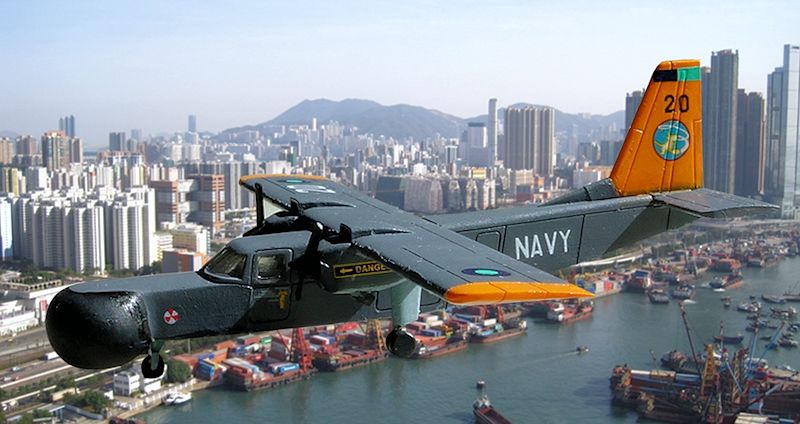
I was lucky enough to fly in an Islander a few years back on one of the
world's shortest commercial routes - the now-defunct hop from the Westman
Islands off Iceland back to Iceland itself. As we got on board, the pilot said,
in that typical restrained Icelandic style, "Welcome on board, flight time will
be six minutes". It was a great flight past spectacular island peaks and across
the grey sand shoreline. It was also a perfect example of the type of work that
the Islander excels at and has kept it in production since 1965.
The military version is slightly longer and has a slightly longer
wingspan. Known as the Defender, it has two underwing hardpoints for light
stores, and sometimes has various sensors attached (like a turreted FLIR) under
the nose. They're used for various tasks by the UK, seemi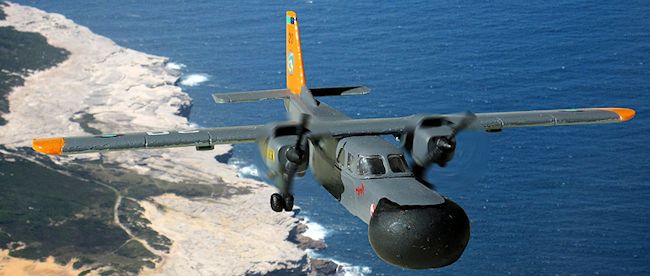 ngly mostly classified
based on what little I can find online.
ngly mostly classified
based on what little I can find online.
At least two were modified with big radomes under the nose. One had the
kind of flat circular radome you typically see under ASW helicopters like the
Lynx or SH-60B. That one seems to have been modified in 1984 as part of the
British Army Corps Airborne Stand-Off Radar CASTOR programme. The other one had
a big fat bulbous radome like you see here and was apparently a prototype AEW
plane. It had a Thorn EMI Skymaster radar and space for two operators and their
consoles, and could surveil 100 nautical miles from 10,000 feet. But the
relatively weak performance of the airframe itself apparently meant that
customers were not really interested. Later this aircraft, or maybe another one
with the same type of radome, was in testing or maybe in service, with who knows
what inside that bubble. I've spent a while reading online but I
can't work it out. Perhaps you can!
Anyway, I wondered what the plane might have looked like if it had in fact
been bought for AEW or maybe maritime surveillance by a smaller country's
air force that couldn't afford, or didn't need, something like an Orion,
Nimrod or Poseidon. In my backstory, this and a few like it were used to
patrol coastal waters for fisheries, counter-piracy and anti-drug
trafficking operations, as well as higher-end military applications if
needed. Smaller South East Asian states spring to mind, with all the
competing maritime claims and bullying by a resurgent China. The little
Baltic states might be another potential customer base, or even Central
American/Caribbean states. I found some small roundels from a country I
can't identify and went ahead.
Don't get sticker shock! The price tag includes a great kit of a Nimrod plus
two other smaller kits - a Merlin HC.3 and the P.1185/AV-16 supersonic
Harrier design project. Still, it's not cheap. You're probably only going to
buy it if you really want a Nimrod (like I did). For a f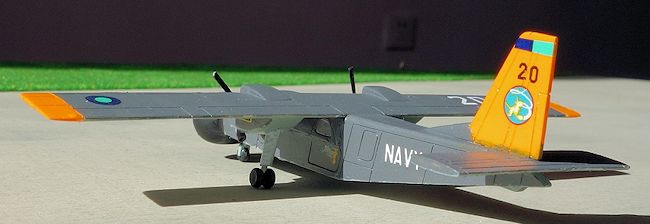 ull preview, have a
look
right here on MM.
ull preview, have a
look
right here on MM.
In brief, this is a lovely little resin kit, very nicely moulded with nice
engraved detail. It has delicate detail and on my copy at least there was
very little by way of surface blemishes. You get two alternative noses -
the regular pointy one and the bulbous radome one. There is a single seat
inside the cockpit and some nice, fine undercarriage and propellors. The
engines have lovely delicate exhaust pipes. The undercarriage is a bit bland
in the wheel area but the main gear fairing is nice.
Happily there were no pinholes or air bubbles that I could see on
this, and the parts were generally very clean. A little trimming was
necessary on the wingtips and the tailplane. The wheels had a tiny bit of
what I guess is flash, and it just rubbed off between my fingers. The radome
and also the front part of the bottom of the fuselage had a bit of what
looked like a seam, though I don't know if that's actually what it was. I
shaved this away carefully with a sharp blade and then gave it a bit of a
rub with some fine sandpaper.
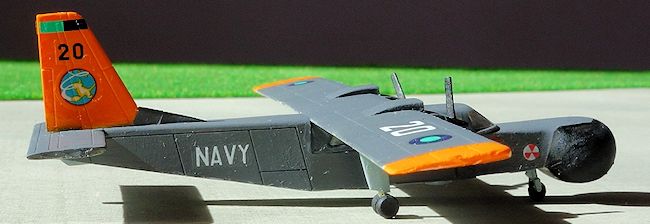 I toyed with building an interior until I realised that just about
nothing would be seen through the windows which are very small despite the
size of the clear resin canopy. They're thick, too. So just imagine that
there are a couple of operator consoles in there.
I toyed with building an interior until I realised that just about
nothing would be seen through the windows which are very small despite the
size of the clear resin canopy. They're thick, too. So just imagine that
there are a couple of operator consoles in there.
The part fit is amazingly good. Once you chop off the excess resin
(like sprue, basically), the quality engineering of this becomes apparent.
To get the tailplane to fit I had to do a little test fitting and trimming,
but the vertical tail went in perfectly. The radome nose fits well too, with
a tiny step underneath that I decided not to fuss with. The wing goes into
the slot on the canopy perfectly. That assembly then fits nicely on the
fuselage, and the engine pods fit the wing equally well. Absolutely no
complaints there.
This is a tail sitter because there is nowhere to put any weight. If
you have a few bits of dense plutonium handy you might be ok! By tipping the
surface so it's slightly downhill, I got it to sit on its wheels properly.
I painted the inside of the cabin and the interior of the clear part
with light grey (Tamiya XF-19) and the instrument panel and coaming flat
black. You really can't see anything through the tiny windows. For the
overall paint job, I contemplating going with a single grey on top, and
maybe a different grey underneath, along the lines of practically every
modern military aircraft. Somehow that seemed pretty boring though, so then
I decided to go with a camouflage scheme. But that seemed a bit unrealistic
for the contemporary era although an image search revealed that Colombia's
new CN-235 maritime patrol plane has a two-tone grey scheme.
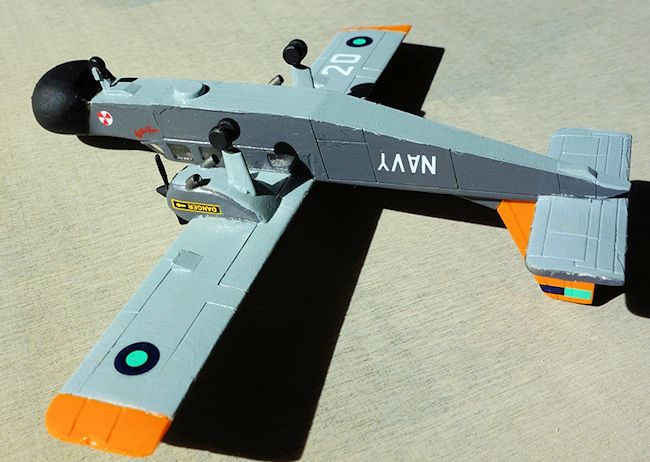 So I did ultimately go with an overall modern dark grey on top, and
a lighter one underneath, but keep some interest by giving it high
visibility wingtips and tail as well as some interesting markings to
brighten up the subtle national insignia. That goes against the modern trend
but I thought that these markings better fitted the kind of operations this
plane would mostly be doing. They could be quickly be painted out if needed
for a real war scenario.
So I did ultimately go with an overall modern dark grey on top, and
a lighter one underneath, but keep some interest by giving it high
visibility wingtips and tail as well as some interesting markings to
brighten up the subtle national insignia. That goes against the modern trend
but I thought that these markings better fitted the kind of operations this
plane would mostly be doing. They could be quickly be painted out if needed
for a real war scenario.
I used Mr Colour 331 Dark Sea Grey for the upper shade and Mr Colour
73 aircraft grey underneath. The radome is matt black and the hi-vis
sections are Tamiya orange.
To make it a bit more visually interesting still, I added some other
decals from the spares department. These included a little radiation symbol
to put near the radome, and some DANGER signs to go near the engines. And I
found a few other data stencils and symbols that looked like they could
belong. It has a tail badge that actually came from a 1/200 Kawasaki C-1
cargo plane, and it has a nose art style name: The Firefly. That came from a
1/144 B-58. I put "NAVY" on the side despite contemplating this as from a
smaller, non English speaking country. Such places often put English
language labels on their planes, so it's realistic enough for a whiffer.
I enjoyed this and I like the way it turned out.
Sure, it's extremely expensive and a tail sitter. But if you're buying the
Nimrod then you will get this too and it is well worth building.
http://en.wikipedia.org/wiki/Britten-Norman_Defender
http://www.spyflight.co.uk/defender.htm
March 2015
If you would like your product reviewed fairly and fairly quickly, please
contact
the editor
or see other details in the
Note to
Contributors.
Back to the Main Page
Back to the Review Index Page


 ngly mostly classified
based on what little I can find online.
ngly mostly classified
based on what little I can find online. ull preview, have a
look
right here on MM.
ull preview, have a
look
right here on MM. I toyed with building an interior until I realised that just about
nothing would be seen through the windows which are very small despite the
size of the clear resin canopy. They're thick, too. So just imagine that
there are a couple of operator consoles in there.
I toyed with building an interior until I realised that just about
nothing would be seen through the windows which are very small despite the
size of the clear resin canopy. They're thick, too. So just imagine that
there are a couple of operator consoles in there.  So I did ultimately go with an overall modern dark grey on top, and
a lighter one underneath, but keep some interest by giving it high
visibility wingtips and tail as well as some interesting markings to
brighten up the subtle national insignia. That goes against the modern trend
but I thought that these markings better fitted the kind of operations this
plane would mostly be doing. They could be quickly be painted out if needed
for a real war scenario.
So I did ultimately go with an overall modern dark grey on top, and
a lighter one underneath, but keep some interest by giving it high
visibility wingtips and tail as well as some interesting markings to
brighten up the subtle national insignia. That goes against the modern trend
but I thought that these markings better fitted the kind of operations this
plane would mostly be doing. They could be quickly be painted out if needed
for a real war scenario.